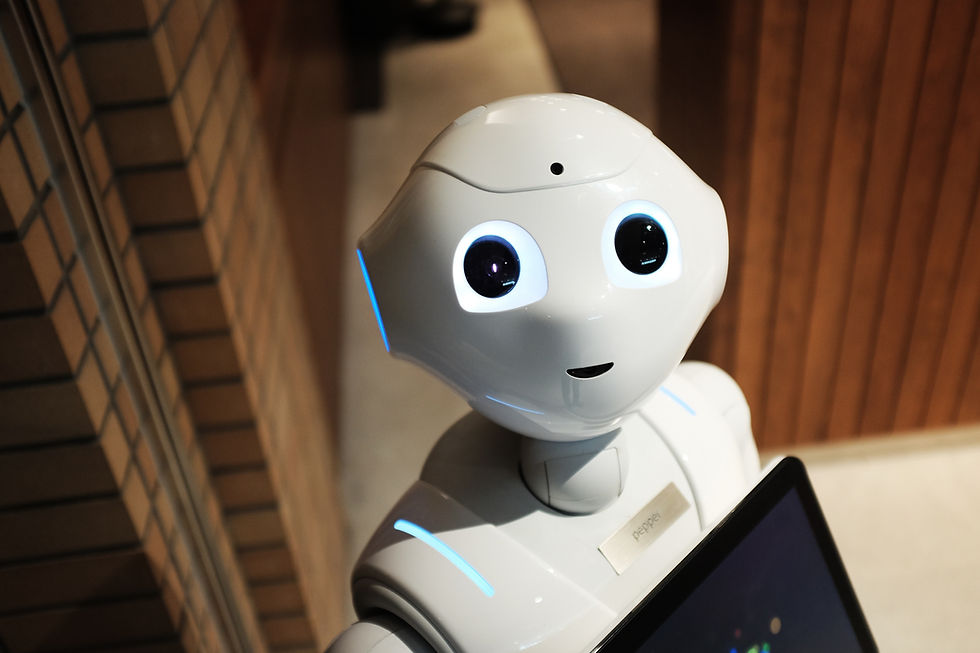The Impact of Generative AI on Economies: Will AI Take Our Jobs?
- Saiabhiram Akkaraju
- Sep 22, 2024
- 4 min read
Updated: Sep 25, 2024

Overview
Generative AI, such as ChatGPT, is revolutionizing the workforce. With AI now passing the bar,
Medical licensing exams and even being qualified to be a sommelier, it seems there's no place
where AI can’t be. But will AI actually take our jobs?
Industries Most Affected
Generative AI is rapidly transforming industries that rely heavily on human time and ideation. In
content creation, for instance, AI can quickly generate articles, make social media posts, create new marketing ideas and so many other things. Similarly, in customer service, AI chatbots and virtual assistants are handling conversations that once required a human touch, but now can be quickly automated to fit a customer's needs.
Software development is another crucial area where AI has made its mark. AI coding assistants, like Github’s Copilot, can create code faster, and with much less errors. In turn, this would reduce the need for entry level programmers, and many software engineers. Data analysis, a very laborious process, has become easily automated with models that can compile and analyze a data set within minutes.
The common theme that is emerging is that AI can quickly replace repetitive industries. AI can
do laborious work very quickly and to a high level, which reduces the need for many different
positions.
Job Creation vs. Job Displacement
While generative AI is a threat to some industries, it is creating others. Regulation of AI is
becoming a lucrative industry, with positions such as AI ethics officers, prompt engineers, and
AI maintenance specialists. These people are critical in overseeing, deploying and maintaining
AI to ensure that it stays a tool and works properly.
However, these roles are proving to be very niche. Due to the fact that AI is so new, while these
industries help, they dont offset the positions that AI could take. This imbalance takes away
security for many different people in the labor force and is raising questions throughout the
world about how to balance the interests of both business and the workforce.
Economic Implications
The widespread adoption of generative AI is predicted to have huge economic implications. AI is not only a technological factor to increase economic growth, but increases productivity and
business output to contribute to the economy as well. MIT’s Future Tech reports, “McKinsey’s
2023 report, would represent an increase in global GDP larger than the current UK economy -
the world’s sixth-largest economy. Even on the low end of the estimates, an increase of $1
trillion annually in added value to global GDP.” This growth is very uneven however. Developments in AI would work to increase economic factors for only certain countries, and risk putting countries that don't invest very behind economically. This would also affect third-world countries, who don't have the adequate infrastructure or capability to implement AI on a wide scale.
The developments in AI also bring up other challenging economic questions for many different
places around the world. Could this exaggerate income inequality? Does AI create job barriers
for entry level workers? Will these changes affect socioeconomic statuses and quality of life for many middle or lower class citizens? All of these questions are major concerns for policymakers and business leaders all throughout the world as we look to the direction that AI will take in our lives.
Will AI Polarize the Labor Market?
The increased use of AI is giving us a new type of labor market trend, polarization. With the use
of AI, High-Skill jobs with a deep technical level, or management are only growing in numbers,
while entry level, lower skilled positions are depleting. This polarization can deepen already
existing economic inequalities, creating a huge barrier to entry for people in lower
socioeconomic situations.
This shift is especially concerning in areas without access to the proper tools for workers to
up skill themselves. In places with a lack of access to education and job training, workers will
have a difficult time transitioning and trying to pick up the necessary skills to be successful. This can create a huge gap between different regions and sets of people in the labor force, and if left to continue, ultimately lead to some form of polarization within the labor market.
Conclusion
Generative AI is a revolutionary tool and will contribute to huge changes in the economy. AI
touches every factor that contributes to economic growth and helps businesses in so many
ways. While it is uncertain what AI will do to jobs, it is certain to be a true test for millions of
people around the world. With Issues ranging from ethics to job displacement, AI is something
that every country around the world has to grapple with. For now there is no certainty of what AI will do to our labor force, and only time will tell.
Bibliography:
Wang, X., Chen, M., & Chen, N. (2024, February 22). How artificial intelligence affects the
labour force employment structure from the perspective of industrial structure optimisation.
Heliyon.
https://www.ncbi.nlm.nih.gov/pmc/articles/PMC10907740/#:~:text=AI%20may%20impact%20the
%20employment,low%2Dskilled%20labour%20in%20others.
Shierholz, H. (n.d.-a). Workers want unions, but the latest data point to obstacles in their path:
Private-sector unionization rose by more than a quarter million in 2023, while unionization in
state and local governments fell. Economic Policy Institute.
https://www.epi.org/publication/union-membership-data/#:~:text=Unions%20improve%20wages,
same%20sector(Bivens%20et%20al.
Varanasi, L. (n.d.). GPT-4 can ace the bar, but it only has a decent chance of passing the CFA
exams. here’s a list of difficult exams the CHATGPT and GPT-4 have passed. Business Insider.
Chui, M., Hazan, E., Roberts, R., Singla, A., Smaje, K., Sukharevsky, A., Yee, L., & Zemmel, R.
(2023, June 14). The economic potential of Generative AI: The Next Productivity Frontier.
McKinsey & Company.
https://www.mckinsey.com/capabilities/mckinsey-digital/our-insights/the-economic-potential-of-g
enerative-ai-the-next-productivity-frontier#business-value
Paige, M. (2024, March 6). Generative AI use case trends across industries: A strategic report.

Commentaires